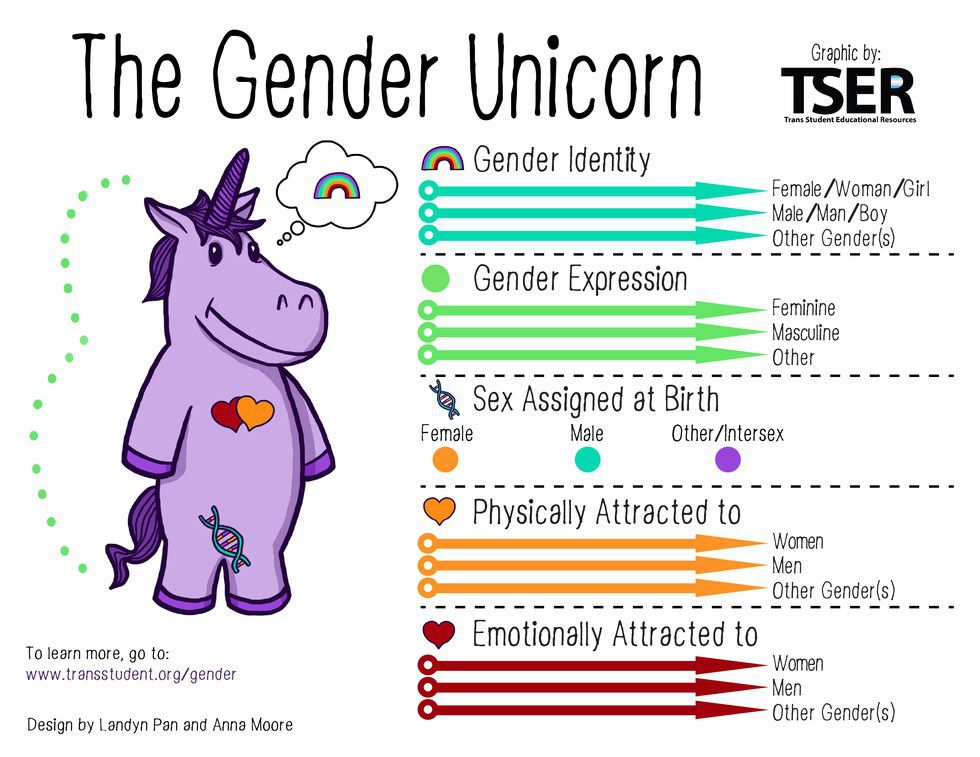Spectrum: noun, plural
Definitions:
1. Physics
An array of entities, as light waves or particles, ordered in accordance with the magnitudes of a common physical property.
2. A broad range of varied but related ideas or objects, the individual features of which tend to overlap so as to form a continuous series or sequence.
I heard the phrase “Gender is a spectrum” for the first time when I was a first-year student. I was in the girls’ locker room changing after swim practice, and as I rung out my wet hair, I eavesdropped on the sophomore girls’ conversation about gender. I understood most of the jargon because, even as a first-year, I had observed that conversations about gender and sexuality are abundant at Brandeis. So when one of my teammates blurted out “Gender is a spectrum,” I thought I knew the meaning behind those words. I knew that spectrum was referring to the fact that genders can be associated with an incredible number of types of sexuality, but I thought this range, while still extremely vast, was limited to terms such as transgender, homosexuality, pansexuality, heterosexuality, queer or bisexuality (I would name more but the list is extensive). Throughout years of interaction with others, professional training and personal research, I learned that lists of vocabulary and terms to define gender are so immense that it should have its own dictionary. But it was not until this year, my third year in college, that I truly understood what my first-year, eavesdropping self heard that day in the locker room.
I was sitting in a “sexual assault and prevention” training when the woman presenting introduced me to someone very important: The Gender Unicorn. I know this character’s appearance is presented as a cartoon, but before you write him/her/they/it off as irrelevant, consider the important message that he/she/they/it carries.
The Gender Unicorn has five categories of identity: Gender Identity, Gender Expression, Sex Assigned at Birth, Physically Attracted to and Emotionally Attracted to. Normal societal constructs dictate that a person’s “Sex Assigned at Birth” category must match their “Gender Identity” category and even that their “Gender Expression” classification must also coincide with the others.
The only category with three isolated choices is “Sex Assigned at Birth." This discrepancy is due to physical, scientific reasons that are relatively restricted due to the limited possibility for (or absence of) only two human genitalia. The majority of society would pigeonhole the rest of the identities, giving them a “male” or “female” option. Sex is different than gender. Sex determines the male or female genitalia assigned at birth, but gender encapsulates the other four categories identified with the Gender Unicorn. And because gender is expressed through identify or attraction, it varies for each person. This is where our phrase comes back: Gender is a Spectrum.
Notice that the other four categories have "Female/Feminine/Woman," Male/Masculine/Men” and “Other” lines instead of dots. This is because every person’s identities fall differently along these lines; they cannot only be classified with isolated “male” and “female” dots. A particularly masculine woman might place her “Gender Identity” marker three tenths past half way on the “Female” line but choose to put her dot marker even further down on the “Male” line. There can be a sexually assigned male who identifies as a male but chooses to express himself as a woman. That same man can be physically attracted to men but emotionally attracted to women. His “dots” would fall in certain places on each arrow of each category and another person in the exact same position could place their dots elsewhere on those lines.
The colored lines have arrows at the end for a reason; every classification has an infinite number of possibilities. Gender is identified, expressed, assigned and felt (mentally and physically) differently by every single person. The possibilities are therefore countless. So while my first-year self would have accepted the limitations of a dictionary on gender vocabulary, I know now that it is impossible to have a comprehensive list of classifications.
Gender is a spectrum. A person’s entire existence cannot be labeled under two possible gender categories. Everyone has his/her/their/its own identity.




















